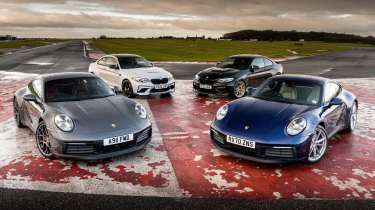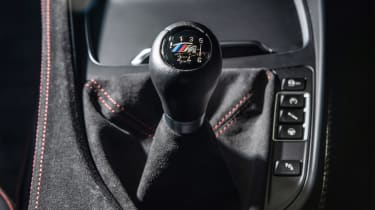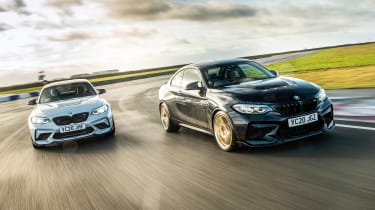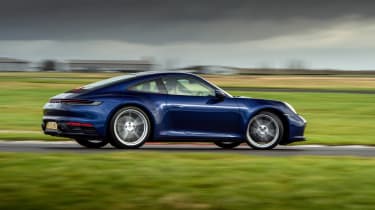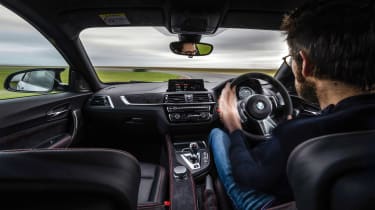Manual v automatic gearboxes: BMW M2 and Porsche 911
Just how much does the choice of transmission affect the dynamics and enjoyment of a car? We head to the test track to find out
You settle yourself in the big, red seat, check the leg-room and assess the view of the screen in front of you. Then there is the eternal question of which of the cup-holders you should place your drink in. Soda safely stowed, the cinema lights dim and you think to yourself, maybe, just maybe, 007 will die this time…
It’s with a similar mindset that I imagine you are beginning this read. Maybe, just maybe, they will say that two pedals are better than three this time…
To be honest this isn’t really about crowning a winner or taking sides. After all, there are plenty of reasons why people choose to or, more pertinently, have no choice but to buy one option rather than the other. No, this is hopefully more nuanced than that. It’s about seeing how much of the driving experience changes when you opt for either three pedals or two. Does a car’s character alter dramatically with an H-pattern rather than a pair of paddles? And if it does elicit a character change, is it more akin to a pre/post full frontal lobotomy comparison or a before/after first coffee of the morning contrast? (I realise that to some people both are equally extreme.)
> BMW M2 CS (2020-2021) review – there's plenty to worry a Porsche Cayman GT4
Now, some will choose a manual purely on principle. Three pedals equals more involvement, therefore it’s the automatic choice, so to speak. However, if you’re sitting on the fence, then are there reasons over and above the pure method of operation that might make one type of transmission a more engaging experience than the other?
To help us investigate all this, there are two trucks in the pitlane of Bedford Autodrome’s West Circuit. One is a Renault Magnum with a manu… only kidding. One is disgorging two versions of the BMW M2 CS, our current evo Car of the Year. The black car with gold wheels is in fact the very car that we crowned eCoty champion in Scotland and it has a six-speed manual ’box. The pale grey car with black wheels is equipped with a seven-speed Dual Clutch Transmission (DCT).
Meanwhile, the other truck is unloading two Porsche 911s. In the dark blue corner is a Carrera S with a seven-speed manual gearbox. In the dark grey corner is a Carrera 4S with an eight-speed Porsche Doppelkupplungsgetriebe (PDK).
Despite this being at a track, there is no intention to strap the timing gear on today. For a start, we know from past experience that the self-swappers will be a bit quicker. Plus there is the muddying complication of the 911s having different driveshaft counts (yes, we did try to get two the same, but it wasn’t possible). Out of interest, the manufacturer claims are that a manual M2 CS is 0.2 seconds slower than a DCT car in a dash to 62mph. The gap is a much wider 0.7sec with comparable 992s because a Carrera S with a manual reaches the benchmark in 4.2 seconds while a PDK car with Sport Chrono does the same sprint in 3.5 seconds.
Initially I’m keen to extract another, perhaps more pertinent performance figure from the cars. First off it’s into the PDK 911 and, after warming it up for a couple of laps, I let it run up to the limiter in second gear. At which point the digital speedo nestled in the analogue rev-counter says I’m travelling at 65mph. A handful of exploratory skids round the long left-hander known as Bank reveals nothing about the gearbox but does feel like quite hard work. It will go sideways easily enough, but trying to maintain the slide is a bit like playing pat-a-cake with an octopus as the all-wheel-drive system shuffles the torque fore and aft. It seems to want to stop the slide rather than stabilise it as in previous 4Ss. Odd.
Back to the pits, into the manual 911, and as soon as you place a foot on the live throttle to pull slowly away you feel a greater sense of connection than in the PDK. With the right-hand pedal solely responsible for revs, it just feels more alert. I think there is inevitably a greater sense of awareness from the driver, too, as engaging the clutch requires a little extra layer of thought.
A few laps, a few slides (much more easily stabilised and sustained; much more enjoyable) and then a full run through second gear. All the way up to an indicated 78mph. That’s tall enough to be first pick in the NBA draft.
In the BMWs it’s a similar story, the DCT matching the PDK with 65mph in second and the manual topping out at 73mph. Curiously, though, the 5mph-lower limit of the BMW does seem to make an appreciable difference in making it feel less long-legged than the Porsche.
Nonetheless, arguably it renders gears three to six/seven in both manuals somewhat redundant on a B-road blast. Perhaps third isn’t totally redundant because the six-cylinder engines are both turbocharged and have maximum torque from 2300rpm and 2350rpm respectively, so you don’t feel totally cheated by short-shifting. Also the Porsche’s flat-six makes its maximum power at 6500rpm, some 1000rpm below the red line, while the BMW’s 444bhp is achieved at 6250rpm, which is 1350rpm before its rev-limiter kicks in. In short, it’s not quite as much of a problem as it is in a Cayman GTS 4.0, which you really want to rev out every time, but the paddleshift cars can certainly claim an initial advantage.
One of the other things that definitely sits in the PDK’s favour is that you really do get a motorsport feel from it. The paddles in a race car would probably be carbonfibre and feel lighter than the metal ones in the 992, but the weighting and zero-slack precision of the action would be right at home in a competition car. Short of throw, no nonsense, almost perfunctory in their performance. A Ferrari’s paddles have more theatre and flair about them, but the efficiency of the Porsche’s is more motorsport.
The way the ratios swap is equally efficient. They are stunningly swift and smooth. A GT3’s ’box may be even faster than a Carrera’s but in isolation you certainly don’t rue the wasted milliseconds. What’s more, there is a sense of complete correlation between paddle and change. There is no delay, no pause for thought, no filter for your fingertip request to go through. It is almost like the direct mechanical connection you get from pulling a sequential lever, even though you are merely activating a switch.
Add all this together and the result is that when you are braking as hard as you can into the hairpin and popping in a barrage of downchanges – bam, bam, bam – you can almost kid yourself that you’re in a race car. Likewise when you’re accelerating hard and pull a perfect, limiter-skimming upshift, there is a sense that it wouldn’t feel that different in an RSR.
By contrast, the manual always feels like a road car gearbox. It doesn’t have the tightness or mechanical directness that you would get in a race car with an H-pattern. Similarly the left-hand pedal doesn’t have the weighting or bite that you would experience in a race car with a competition clutch. It is not a bad shift, far from it. It’s just very obviously designed for a road car not a race car.
Curiously the same feelings don’t really occur with the BMWs. Part of the reason for this is that the DCT paddles feel too flimsy and their action is too inconsequential. They lack the right amount of gravitas. By contrast, the speed with which you can sling the gearstick around the black car’s gate is a little more track-orientated than in the Porsche. It’s still obviously a road car ’box, but you can imagine it being OK if left unchanged in an entry-level racer.
Talking of race car vibes, it’s a shame that neither the DCT nor the PDK really offers the option to shift with a selector. Pretending you’re in a Super Touring car or an R5 rally car really can elevate an experience. The PDK’s glorified switch doesn’t offer any option for doing this at all and many (including, judging by the latest GT3, Porsche’s own GT department) have bemoaned the passing of the old selector. It seems to be a common theme in many cars these days – particularly those that fall under the VAG umbrella. The BMW’s beautiful small teardrop does allow you to shift up and down, but sadly it is so small that it’s hardly worth the long reach to do so.
Spending time in any CS is definitely worth it though. Regardless of the gearbox, the small BMW coupe’s chassis is a thing of pure joy. It is just so fantastically adjustable, as comfortable as a fireside armchair once you’re over the limit. This is highlighted on one particular run through a corner. I’m pottering round pondering ratios and then suddenly spot Aston Parrott giving the international sign for ‘stop pottering’. A flick of the wrists, a stomp on the throttle, round go the rear wheels and the M2 sits into a sumptuous, slightly smokey slide and proceeds to gather pace all the way to the exit kerbs. It wouldn’t have been easier if it was a Hot Wheels on some lino.
Anyway, back to the ’boxes, although this ease of balance is actually pertinent to them. You see, in the manual there are some tricky shifts to be made during a lap of the West Circuit. For example, I’ve always found the late back-and-across to second as you head towards the first apex of the Beckham Esses to be a bit awkward because it’s very easy to unsettle the car. It’s tricky enough with DCT or PDK because you need to get the car transitioning from the long left on entry into the tight right, then manage the weight transfer smoothly back the other way into a long left. At this time of year it’s also very slippery on the apex of the right-hander. Get your heel and toe even slightly wrong, destabilise the rear axle and you’re still gathering up the results half way through the Palmer Curves.
In the manual 911 I found I was even more wary of this. The legendary rear-engined balance is a wonderful thing in many respects, but it certainly takes a little care in a complex like this. By contrast, the manual BMW has such an easy demeanour that you have confidence to grab it by the scruff, chuck it around and know that all will be well. If you unsettle it a bit with a shift, you know that you can keep the slide small or, if it does get big, you can easily ride it out and almost certainly make the transition back the other way. With the Carrera S you just need to be that bit more precise or tentative.
The other interesting thing about driving DCT and manual one after the other is that the M2 CS feels slightly more relaxed with just the six ratios. The underlying handling balance is the same in both and equally enjoyable, however there’s no doubt in my mind that the slightly taller gearing in the manual made the torque delivery seem even smoother and more predictable. It’s subtle but with the manual the car just feels more settled and at ease, certainly on a slippery circuit. Some of that may be down to the way DCT executes its shifts, as BMW’s system has always been among the most aggressive of the dual-clutch ’boxes (which is why I’m not so disturbed by the switch to an auto in the latest M3). PDK feels equally swift to shift but creamier in its control.
I love this sort of comparison test. In many ways it’s overly niche, but it is also fascinating to delve deeper. The overarching concerns of convenience or sense of connection will be far more likely to sway you one way or the other when choosing which gearbox to have, but it’s absorbing assessing how individual cars feel with different pedal counts.
Objectively I think it’s a hard call to make with the 992. I would have a manual because I like manuals, but I think the car is probably a better, more complete package with PDK. It’s not that the manual feels like an afterthought, just that the slightly larger, more tech-laden, more everyday demeanour of the latest 911 seems like it was designed around PDK.
Conversely, in the more focused BMWs I felt the opposite. If you have the choice then I would wholeheartedly recommend getting the M2 CS with three pedals rather than two. It’s not that a DCT-equipped CS isn’t hugely enjoyable, just that the whole package feels like it reaches an absolute sweet-spot with the manual. So, James Bond lives to wield his Walther another day and our stance on gearboxes remains the same. A good paddle-shift is preferable to a mediocre manual. But a good manual is still the ultimate.
This story was first featured in evo issue 285.

